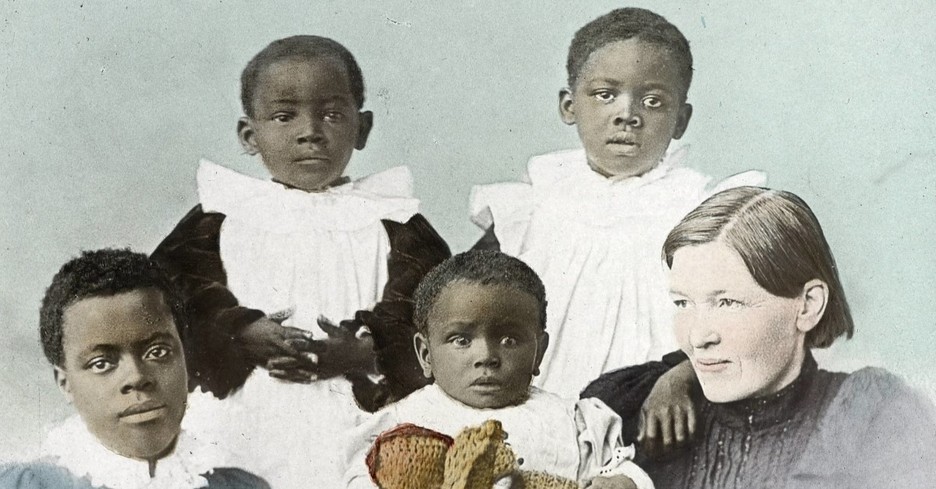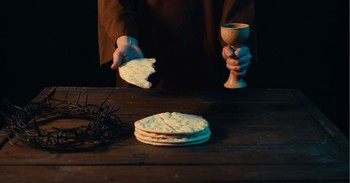
In the last issue of Glimpses for Kids we learned about young Mary Slessor and her bravery in sharing God's Word with street kids of Scotland in the 1860's. This issue now follows Mary's adventures as a missionary in Calabar, Africa. Let's listen in to hear how her adopted daughter, Janie, might have told her story.
"Janie, come help me pack," called Ma. "We're moving to Okoyong."
"Okoyong?" I asked. I squatted beside Ma, who was hovering over her luggage, sorting medicine bottles. "But Ma, there are head hunters in Okoyong!"
The White Ma touched my dark face, a twinkle in her blue eyes. "Ah, but Janie, the people of Okoyong have never heard the gospel! We must tell them about Jesus!"
The gospel was a subject that Mary Slessor, my adopted ma, could not be talked out of. I knew we were going, despite the elephant stampedes, twisting tornadoes, and slithering cobras. Still, I didn't want to be anywhere else than with Ma.
Rescuing Babies
Ma was the bravest woman I knew. Her short hair was the color of flames and her love was always big enough to rescue one more dying baby. Everyone in Calabar loved her.
The natives in Calabar thought that if a woman had twins, one of them had to be a devil, so they left twin babies in the jungle to die. I was one of the first twins that Ma rescued and, in my heart, I wanted to be her special girl forever.
Distant Drumming
King Eyo Honesty VII of Old Town hired 30 canoe paddlers and on August 3, 1888, we traveled up the Calabar River toward Okoyong in his grandest canoe. Ma and five of us children sat on colorful cushions, surrounded by blankets and supplies. We arrived to the sound of distant drumming. In Africa, we dance to the drums for many reasons--a wedding, a funeral, a feast, to relay messages or. . . to start a war!
Ekenge, the nearest village in the land of Okoyong, was four miles away. The boat paddlers were too afraid to go with us, so we walked alone. Carrying all our supplies and the baby, we struggled through the dark jungle, listening to the drumming as we went.
All at once, my feet flew sideways in the mud. Packages flew, but at least I managed to keep the baby from falling. When I stood up, the little one started crying.
"Don't cry," Ma urged. "Jesus is watching over us. Let's sing."
Welcome to Ekenge
Hours later, we stumbled into Ekenge, out of breath from all our singing and walking.
The great Chief Edem stood at the entrance to the village. "You are welcome, Ma," he said, bowing. "The drums of many villages told me you were coming. We have all heard of your wisdom. I have a house ready for you as long as you will stay."
"Wow!" I whispered. "What a welcome!" Ma squeezed my hand.
"Thank you, Chief Edem," Ma answered. "I would like to speak to your people when the sun rises."
I was tired in the morning, but I helped Ma put up a wooden plank and lay the white tablecloth over it. I got out Ma's Bible for her, and the older boys made a wooden cross and propped it up in front of the table.
We sat on small benches, holding the little ones, and sang at the top of our lungs. Chief Edem came first, and then the villagers followed.
Ma glowed like a candle in the morning light as she witnessed to the villagers about Jesus for the first time.
The next morning, I helped Ma set up that same wooden plank, only this time it became a table for all her medicine bottles. I watched our little ones so Ma could give out medicine to the sick people.
That night, after the others were asleep, Ma crawled onto the floor mat beside me. "The Ekenge don't seem to be so wild, Janie," Ma whispered as she pulled the blanket around us.
"It is because you are famous, Ma," I told her in the darkness. "Everyone in Okoyong calls you the White Queen."
"Then we will make Jesus the famous King in Okoyong," Ma answered. She yawned and within seconds her snoring told me she was asleep.
We lived in Ekenge for more than a year, but Ma traveled to other villages to preach the gospel and give medicine while I stayed with our little ones. I grinned whenever I saw big Chief Edem sitting on the benches among the small children, reciting his Bible lesson to the White Ma.
"Ma!" I cried as soon as I saw her coming. "Chief Edem is sick and the witch doctor has taken prisoners!"
Ma took off running and I followed her into Chief Edem's hut.
"Witchcraft," the chief mumbled. "Someone put a spell on me."
"That's not true!" cried Ma.
I gasped. No one talked to Chief Edem in this way.
"You are sick because you ate dirty food," said Ma. "Wait here. I'll go get you some medicine."
The chief became well with Ma's medicine. The next night, the chief freed the prisoners and the village celebrated with loud, clamorous drumming and a great party.
"No one will die tonight," I told Ma.
She smiled. "Yes, the prisoners won't die now, Janie. And one day, I will bring the gospel to Chief Nijri."
"Chief Edem says that Nijri is the fiercest chief in all of Okoyong," I answered. "Can't you pick a nicer person?"
Ma smiled at me, the answer in her eyes. Ma always chose the worst, the outcast, the most wicked and brought them the gospel that would save them.
After two years, Okoyong had changed from a wild ferocious land into peaceable villages that worshipped God. We were ready to go back to Old Town.
Ma and I went on many adventures in the jungles of Calabar. She told me I was always her girl, and I never left her side. Her fame spread all over the jungles of Calabar and the world, and I was proud that she was my special White Ma.
Make It Real! Questions to help you dig a little deeper and think a little harder.
1. In order to reach the African people effectively, Mary lived just as they did. What kinds of conveniences do you think she gave up in order to live among African tribes?
2. What modern conveniences would be the hardest for you to give up if you were to live as Mary did?
3. Missionary work involves more than just telling people about Jesus. In what ways did Mary show the gospel to those she was trying to reach?
4. One of the ways African people used drums was to communicate. What forms of communication were in use in other parts of the world at that time?
Suggested reading:
Trial by Poison by Dave & Neta Jackson (Trailblazer Books, Bethany House)
Mary Slessor: Queen of Calabar by Sam Wellman (Heroes of the Faith series, Barbour)
Photo Credit: Public Domain image from University of Southern California archives, via Wikimedia Commons.
This article is part of our People of Christianity catalog that features the stories, meaning, and significance of well-known people from the Bible and history. Here are some of the most popular articles for knowing important figures in Christianity:
How Did the Apostle Paul Die?
Who are the Nicolaitans in Revelation?
Who Was Deborah in the Bible?
Who Was Moses in the Bible?
King Solomon's Story in the Bible
Who Was Lot's Wife in the Bible?
Who Was Jezebel in the Bible?
Who Was the Prodigal Son?


